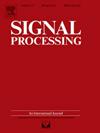Underwater multi-sensor multi-target bearing-only tracking based on delayed measurements
IF 3.4
2区 工程技术
Q2 ENGINEERING, ELECTRICAL & ELECTRONIC
引用次数: 0
Abstract
The multi-sensor bearing-only tracking system plays an important role in underwater target localization. However, due to propagation delays, observations from multiple sensors at the same time are asynchronous, as the signals are emitted from the target at different moments, creating a time offset issue. Additionally, as the relative distance between the target and sensors changes, the time intervals between two consecutive observations by the sensors also vary. Furthermore, missed detections, false alarms, and target birth and death phenomena negatively impact state estimation. To address these issues, this paper proposes a multi-sensor bearing-only tracking algorithm that considers propagation delay. Using the Gauss–Helmert model to achieve accurate state transitions, the algorithm establishes kinematic and temporal constraints between multi-sensors. Simultaneously, it employs a loopy belief propagation method to calculate the posterior probabilities of each target and perform fusion updates. To improve tracking accuracy in complex environments, a time decay factor is proposed to reduce the covariance of sensors with higher delays, and a trajectory birth-and-death management strategy combined with delayed decisions is proposed. Simulation results show that this algorithm outperforms traditional algorithms that ignore propagation delays in state estimation accuracy and perform better than existing bias compensation algorithms in environments with false alarms and missed detections.
基于延迟测量的水下多传感器多目标单方位跟踪
多传感器纯方位跟踪系统在水下目标定位中起着重要作用。然而,由于传播延迟,同时来自多个传感器的观测是异步的,因为信号在不同的时刻从目标发出,从而产生时间偏移问题。此外,随着目标与传感器之间相对距离的变化,传感器两次连续观测的时间间隔也会发生变化。此外,漏检、误报和目标出生和死亡现象会对状态估计产生负面影响。为了解决这些问题,本文提出了一种考虑传播延迟的多传感器纯方位跟踪算法。该算法利用Gauss-Helmert模型实现精确的状态转换,建立了多传感器之间的运动和时间约束。同时,采用循环信念传播方法计算各目标的后验概率并进行融合更新。为了提高复杂环境下的跟踪精度,提出了一种时间衰减因子来减小高时延传感器的协方差,并提出了一种结合延迟决策的轨迹生死管理策略。仿真结果表明,该算法在状态估计精度上优于忽略传播延迟的传统算法,在虚警和漏检环境下优于现有的偏置补偿算法。
本文章由计算机程序翻译,如有差异,请以英文原文为准。
求助全文
约1分钟内获得全文
求助全文
来源期刊

Signal Processing
工程技术-工程:电子与电气
CiteScore
9.20
自引率
9.10%
发文量
309
审稿时长
41 days
期刊介绍:
Signal Processing incorporates all aspects of the theory and practice of signal processing. It features original research work, tutorial and review articles, and accounts of practical developments. It is intended for a rapid dissemination of knowledge and experience to engineers and scientists working in the research, development or practical application of signal processing.
Subject areas covered by the journal include: Signal Theory; Stochastic Processes; Detection and Estimation; Spectral Analysis; Filtering; Signal Processing Systems; Software Developments; Image Processing; Pattern Recognition; Optical Signal Processing; Digital Signal Processing; Multi-dimensional Signal Processing; Communication Signal Processing; Biomedical Signal Processing; Geophysical and Astrophysical Signal Processing; Earth Resources Signal Processing; Acoustic and Vibration Signal Processing; Data Processing; Remote Sensing; Signal Processing Technology; Radar Signal Processing; Sonar Signal Processing; Industrial Applications; New Applications.
 求助内容:
求助内容: 应助结果提醒方式:
应助结果提醒方式:


